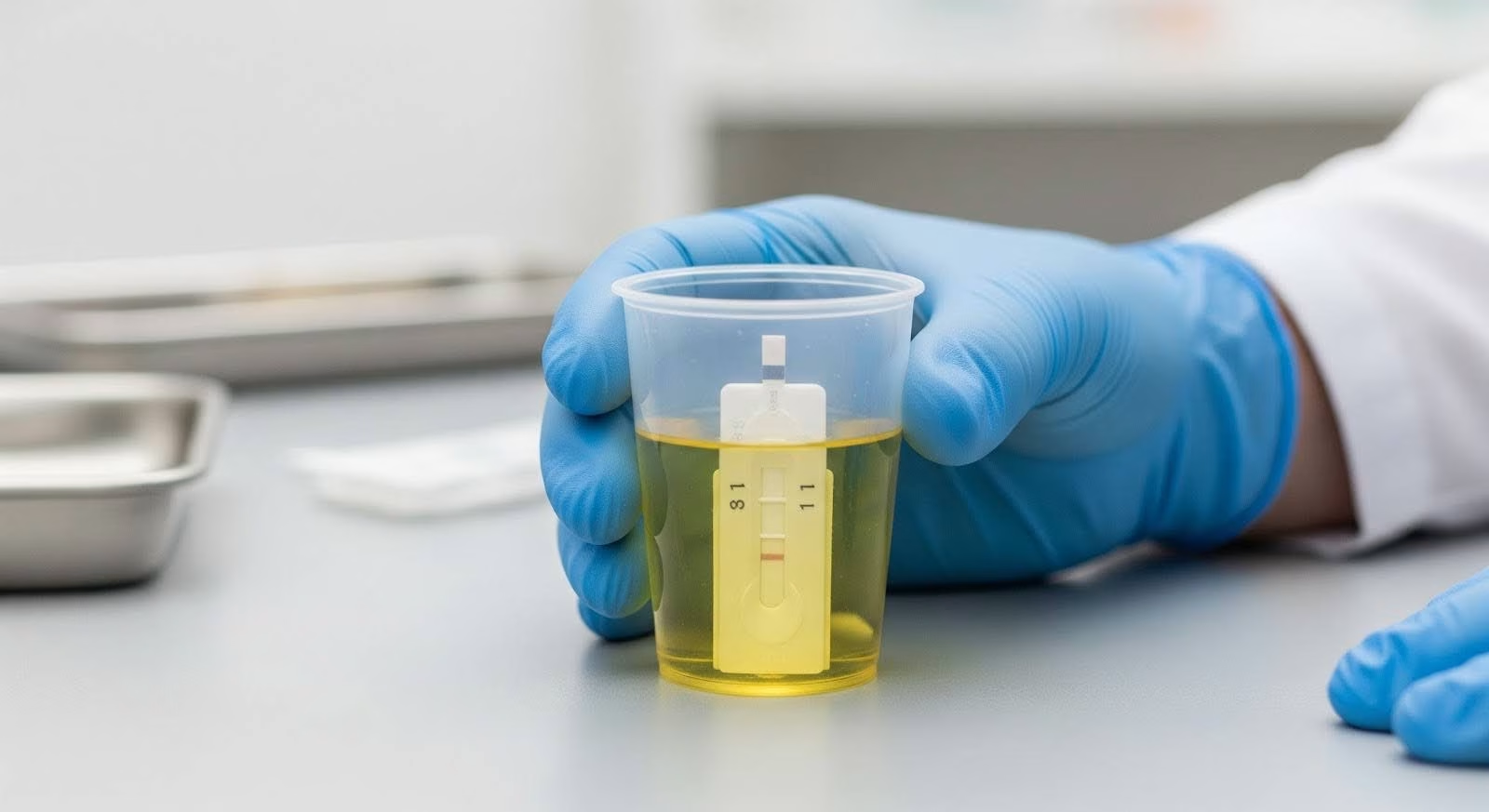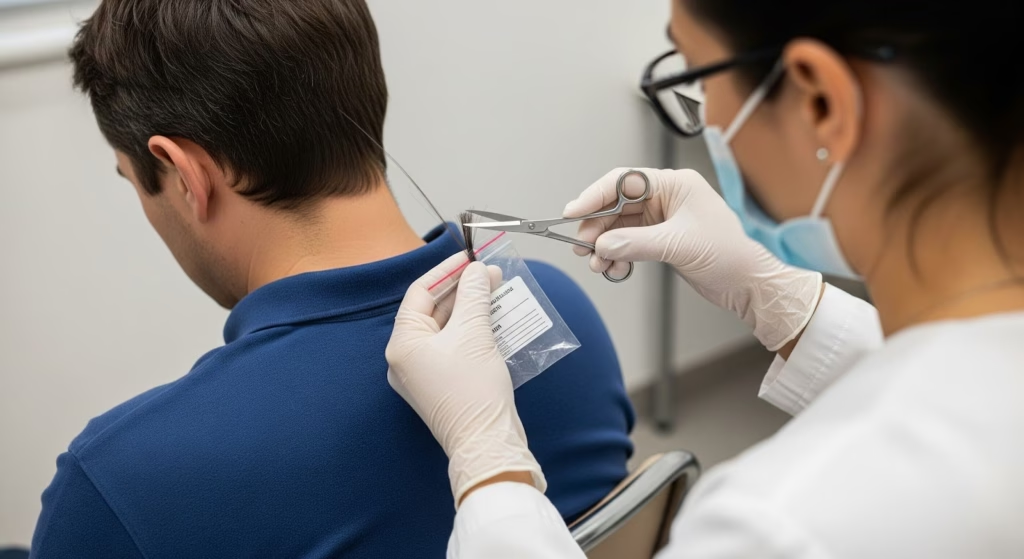
Kratom does not appear on typical workplace drug tests.
Standard 5-, 10-, and 12-panel screens used by employers and probation programs exclude kratom alkaloids unless a specialized kratom assay is specifically ordered, which requires immunoassay screening at 5 ng/mL and confirmation via liquid chromatography–tandem mass spectrometry at 1 ng/mL for mitragynine and 7-hydroxymitragynine.
This article explains which tests detect kratom, how the technology works, and what that means if you face drug screening at work, in treatment, or through the justice system.
Does Kratom Show Up on Standard Drug Tests?
No. Kratom does not show up on a drug test when that test follows the standard 5-, 10-, or 12-panel format used across the United States.
These routine panels screen for marijuana, cocaine, amphetamines, opiates, PCP, and sometimes additional classes like benzodiazepines or barbiturates, but mitragynine and 7-hydroxymitragynine, the active alkaloids in kratom, are not part of those default cutoff tables.
The reason is straightforward. Standard workplace and criminal justice panels align with federal guidance that focuses on scheduled controlled substances. Kratom remains unscheduled at the federal level, and the Department of Transportation, SAMHSA, and NIDA model panels exclude kratom alkaloids entirely.
In January 2025, HHS and SAMHSA published updated authorized drug testing panels for federal workplace programs, effective July 7, 2025, specifying Schedule I and II drugs and biomarkers; kratom was not listed.
Even extended employer panels that add tramadol, fentanyl, or synthetic cannabinoids typically omit kratom unless the ordering party explicitly requests it.
A Labcorp clinical test for kratom, test code 791750, requires a separate order and uses a 5.0 ng/mL immunoassay screen with 1.0 ng/mL LC–MS/MS confirmation cutoffs, illustrating that kratom testing is available but must be consciously added to a panel.
This means you can use kratom and pass a standard drug test, because the test is not looking for kratom. The critical qualifier is “standard.” Specialized tests exist and are increasingly deployed in certain settings, which we cover next.
When Kratom Can Be Detected?
Kratom shows up on a drug test only when the test specifically targets mitragynine and 7-hydroxymitragynine. Three contexts drive kratom testing today.
Clinical and rehabilitation settings. Pain management programs and substance use treatment facilities order kratom assays when kratom might interfere with opioid therapy or complicate withdrawal care.
Quest Diagnostics advises clinicians to consider adding kratom panels in regions with high prevalence, and Aegis Sciences markets urine and oral fluid kratom tests that include mitragynine, 7-hydroxymitragynine, and mitragynine pseudoindoxyl for treatment monitoring.
Hospitals and rehab centers that run comprehensive toxicology workups may include kratom to assess poly-substance use or manage medication interactions.
Selective employer policies. Some safety-sensitive employers choose to add kratom testing, particularly where local kratom use is common or after adverse incidents.
Major clinical laboratories like Labcorp and MedTox sell turnkey kratom screening and confirmation services, making it simple for an employer to expand a panel if policy permits and budgets allow. Still, these remain exceptions rather than the rule; most general employers stick to the cheaper, federally guided standard panels.
Probation and corrections programs. Evidence suggests kratom testing in criminal justice is uncommon. Kentucky’s Department of Corrections reported in 2022 that it had no kratom testing capability when lawmakers proposed scheduling kratom, and the agency projected minimal-to-moderate system impact if testing were required.
That scheduling bill failed, and Kentucky instead enacted a Kratom Consumer Protection Act in 2024, reducing any statewide mandate to test. Probation programs generally focus on high-incidence drugs unless a judge or case officer orders an expanded panel.
The point is that detection depends entirely on program intent and explicit ordering decisions. Technology is not the barrier; choice is.

How Do Drug Tests Detect Kratom?
Drug testing technology for kratom has matured significantly over the past decade, even if deployment remains selective.
Immunoassay screening. Kratom immunoassays have been commercially available since at least 2013, when Randox released a mitragynine ELISA. Today, labs like Labcorp use immunoassay screening at cutoffs as low as 5 ng/mL to flag presumptive kratom positives.
However, immunoassays are inherently less specific than mass spectrometry, so any positive screen should be confirmed by LC–MS/MS to rule out cross-reactivity and identify the exact alkaloids present.
Liquid chromatography–tandem mass spectrometry. LC–MS/MS is the gold standard for kratom confirmation and for programs that skip screening altogether and go straight to definitive testing.
This method separates and identifies mitragynine, 7-hydroxymitragynine, and related compounds at very low detection limits. Labcorp confirms mitragynine and 7-hydroxymitragynine at 1.0 ng/mL, and Aegis includes mitragynine pseudoindoxyl, a potent biotransformation product that has grown in clinical interest recently.
Mass spectrometry provides structural specificity, meaning it can distinguish kratom alkaloids from opioids, other indole compounds, or potential interferents.
Oral fluid testing. Oral fluid captures the parent drug shortly after use, making it ideal for detecting very recent exposure. Aegis offers oral fluid kratom assays for mitragynine and 7-hydroxymitragynine, with a detection window spanning minutes to approximately 48 hours.
This short window contrasts with urine, which detects metabolites over several days, and the difference can produce legitimate discordant results where one matrix is positive and the other negative.
Hair and specialized matrices. Hair testing for kratom is validated and used in forensic contexts to document longer-term exposure, with detection limits as low as 0.05 pg/mg for mitragynine and 0.2 pg/mg for 7-hydroxymitragynine.
ARUP Laboratories also offers umbilical cord tissue testing for mitragynine and speciociliatine to document fetal exposure during the last trimester, serving neonatal care and child protection evaluations.
These modalities are not used for routine workplace screening but demonstrate the breadth of analytical capability when kratom testing is clinically or forensically warranted.
Kratom does not cross-react with standard opiate or opioid immunoassays. Mitragynine and 7-hydroxymitragynine are chemically distinct from morphine, codeine, oxycodone, and fentanyl, so kratom use alone will not trigger a positive opioid result.
Contaminated kratom products containing fentanyl or other adulterants could cause an opioid positive, but that reflects the adulterant, not kratom itself.
| Test Type | Typical Cutoff | Detection Window | Common Use |
| Urine immunoassay | 5 ng/mL | Up to ~5 days | Clinical/employer screening |
| Urine LC–MS/MS | 1 ng/mL | Up to ~5 days | Confirmation after positive screen |
| Oral fluid LC–MS/MS | Lab-specific | Minutes to ~48 hours | Recent-use detection |
| Hair LC–MS/MS | 0.05–0.2 pg/mg | Weeks to months | Forensic/long-term documentation |
| Umbilical cord tissue | 0.08 ng/g | Last trimester exposure | Perinatal/neonatal evaluation |
Do Employers Test for Kratom?
Most employers do not test for kratom because their panels follow standard federal templates that exclude unscheduled substances like kratom.
The Department of Transportation relies on SAMHSA-certified laboratories and panels that target controlled substances such as marijuana, cocaine, amphetamines, opiates, and PCP. Kratom is not included in DOT testing programs, and non-DOT employers typically adopt similar cost-effective panels.
Safety-sensitive industries represent the exceptions. Employers in transportation, heavy machinery operation, or healthcare may choose to add kratom when local use prevalence is high or after workplace incidents raise concerns.
The decision hinges on policy, budget, and perceived risk, not on technical feasibility. Clinical laboratories offer off-the-shelf kratom panels that integrate seamlessly into existing test menus, so expanding a drug screen is administratively straightforward once leadership commits.
State and local policy also influence employer decisions. Rhode Island transitioned from a kratom ban to enacting the Rhode Island Kratom Act in 2025, legalizing regulated kratom for adults 21 and older with licensing and a 15 percent wholesale tax effective April 1, 2026.
This regulatory shift may reduce employer urgency to test in that state. Conversely, jurisdictions that restrict or heavily regulate kratom may see higher testing adoption among local employers concerned about compliance or liability.
A late 2024 and early 2025 market development is worth noting. The Center for Forensic Science Research & Education reported that 7-hydroxymitragynine emerged as the primary component in some retail products marketed as kratom, with significantly higher potency than mitragynine.
This prompted calls for federal regulatory clarity and increased clinical attention. Laboratories like Aegis expanded their panels to detect 7-hydroxymitragynine and mitragynine pseudoindoxyl in response, and some policymakers urged FDA action to distinguish natural kratom from synthetic or enriched 7-hydroxymitragynine products.
This evolving product landscape could nudge more safety-sensitive employers toward targeted kratom testing, though broad inclusion in routine panels remains unlikely without federal scheduling.
Do probation programs test for kratom? Generally no, but with exceptions. The Kentucky Department of Corrections lacked kratom testing infrastructure in 2022 and anticipated new costs if the state scheduled kratom.
The scheduling bill did not pass, and Kentucky later adopted a consumer protection framework, reducing statewide testing pressure. National Institute of Justice project listings show forensic labs developing improved kratom detection methods as casework prevalence grows, but that research interest has not yet translated into routine probation panel inclusion.
Individual probation officers or judges can order expanded testing when kratom is relevant to a specific case, but system-wide kratom testing remains rare.
Rehabilitation clinics and pain management practices represent the most frequent requestors of kratom testing. Kratom can confound opioid therapy monitoring, precipitate withdrawal, or interact with prescribed medications, making detection clinically valuable.
Quest Diagnostics recommends that clinicians consider kratom panels where use is suspected, and Aegis actively markets kratom testing to treatment providers. The short detection window of oral fluid makes it useful for assessing very recent use during intake or after suspected relapse, while urine remains the standard for ongoing monitoring over days.
Detection Windows and Methods
Understanding when and how kratom can be detected helps interpret test results and assess risk.
Urine detection:
Mitragynine has a terminal half-life of approximately 68 hours at steady state in human pharmacokinetic studies, and 7-hydroxymitragynine shows a half-life up to 25 hours after multiple doses. These pharmacokinetics support multi-day detectability in urine.
Labcorp and MedTox screen at 5 ng/mL by immunoassay and confirm at 1 ng/mL by LC–MS/MS, meaning even low-level use can be detected when a kratom-specific test is ordered.
Clinical lab guidance typically cites detection windows of up to five days for occasional users, with potential extension in chronic, heavy users due to accumulation.
Hair detection:
Hair testing documents long-term exposure, typically spanning weeks to months depending on hair length and segment analysis.
Validated LC–MS/MS methods achieve limits of detection at 0.05 pg/mg for mitragynine and 0.2 pg/mg for 7-hydroxymitragynine in authentic samples, with concentrations ranging from 16 to 2067 pg/mg for mitragynine in forensic case series.
Hair is rarely used for routine employment testing but serves forensic, child custody, and chronic-use documentation needs.

Oral fluid detection:
Oral fluid captures parent alkaloids shortly after consumption and retains them for approximately 48 hours. Aegis offers oral fluid testing for mitragynine and 7-hydroxymitragynine, suitable for post-incident testing, suspected impairment evaluations, or treatment intake assessments.
Because oral fluid and urine reflect different analyte forms and time windows, simultaneous testing can legitimately produce discordant results, one positive, the other negative, even when both tests are valid.
Umbilical cord tissue:
ARUP’s qualitative LC–MS/MS test on umbilical cord detects mitragynine and speciociliatine at a cutoff of 0.08 ng/g, documenting fetal exposure during the last trimester.
This test supports neonatal withdrawal assessment and child protection decisions but is obviously not relevant to employment or adult probation screening.
The key takeaway is that kratom detectability hinges on test selection, not on technological limits. Modern LC–MS/MS methods are highly sensitive and specific; kratom will be found if the test looks for it. The gatekeeper is the ordering party’s choice to include kratom alkaloids in the panel.
Why Does This Matter for Your Situation?
If you use kratom and face drug testing, understanding panel composition is essential. Standard workplace and probation tests will not detect kratom unless a specialized assay is added.
That means kratom use typically will not jeopardize employment or supervision status when only routine panels are in play. However, assumptions are risky.
Confirm what your employer, court, or program actually tests for. Ask the testing coordinator or review written policy. If the panel includes “kratom,” “mitragynine,” or “additional analytes,” you are being tested.
For individuals in treatment or pain management, kratom testing is increasingly common because clinicians need to know what substances you are taking to safely manage medications and monitor progress.
Withholding kratom use from your provider can lead to harmful interactions or misinterpretation of symptoms. Transparency supports better care.
Product quality and adulteration matter. Some kratom products have been found to contain fentanyl, synthetic opioids, or elevated concentrations of 7-hydroxymitragynine. Using adulterated kratom could cause an opioid positive on a standard test, even though pure kratom would not.
This risk underscores the value of purchasing from reputable vendors in states with consumer protection laws and being honest with healthcare providers about what you are taking.
Policy is fluid. Rhode Island moved from prohibition to regulated legalization in 2025. Kentucky enacted consumer protection standards after a criminalization bill failed. Other states maintain bans or are considering new regulations.
Local legal status influences both the likelihood of testing and the consequences of a positive result. Staying informed about your state’s kratom laws helps you assess risk accurately.
The rise of concentrated 7-hydroxymitragynine products marketed under the kratom label may change testing dynamics. These products are more potent than traditional kratom leaf powder and have drawn clinical and regulatory attention.
Some labs now include mitragynine pseudoindoxyl and 7-hydroxymitragynine in expanded panels to capture the full range of kratom-related exposures. If you use these products, be aware that testing technology is catching up and that potency increases may elevate safety concerns among employers and treatment providers.
Testing yourself at home with over-the-counter kratom strips is an option, but interpret results cautiously. Consumer strips often use higher cutoffs, 100 to 500 ng/mL, compared to laboratory confirmation at 1 ng/mL.
A negative on a home test does not guarantee a negative on a lab test. If stakes are high, consider sending a sample to a laboratory that offers kratom LC–MS/MS confirmation.
Kratom does not appear on standard drug tests, but it is detectable when tests are designed to find it. The landscape is shifting as clinical labs expand offerings, state policies evolve, and new product forms enter the market.
Knowing what you face, and which tests apply to your situation, puts you in control of your choices and your outcomes.
If you or someone you care about is navigating substance use challenges or facing the complexities of drug testing in treatment, reaching out for support can make all the difference. At Thoroughbred Wellness & Recovery, we offer compassionate, evidence-based care that treats the whole person, not just the test result.
Our team in Marietta, Georgia, provides detox, residential, and outpatient programs personalized to your unique needs, with integrated mental health and addiction treatment rooted in clarity, bravery, and authenticity. Call Thoroughbred 678-726-5503 anytime, day or night, to speak with an admissions specialist who can answer your questions and help you take the next step toward lasting freedom.









